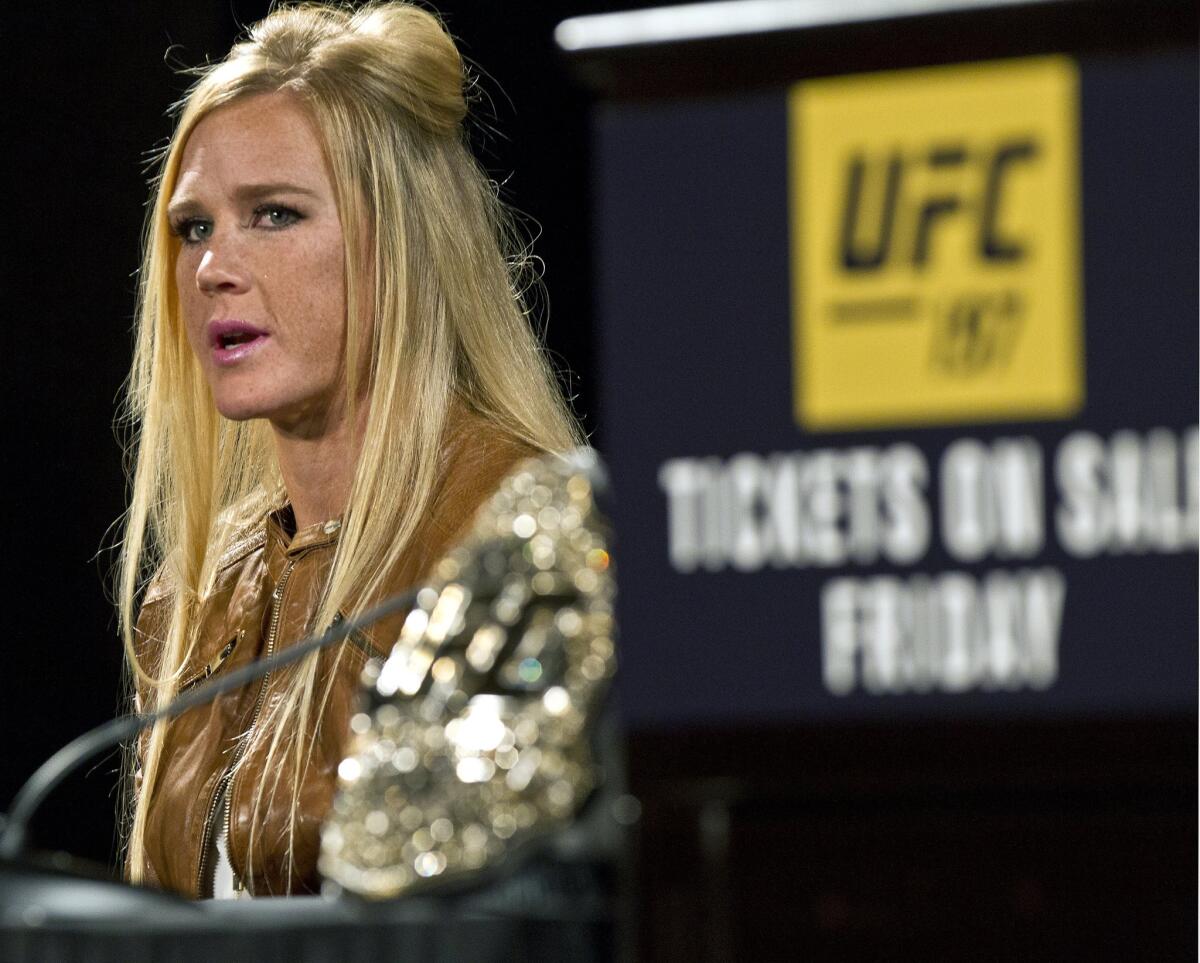Women’s boxing hopes to gain traction from Holly Holm’s UFC victory over Ronda Rousey

UFC 197 fighter Holly Holm answers a question during a news conference at the MGM Grand in Las Vegas.
- Share via
Among the millions who watched former boxing world champion Holly Holm outpunch Ronda Rousey to set up a stunning upset was Mauricio Sulaiman. The head of the World Boxing Council’s pulse raced at the sight.
Certainly, what Holm did to the previously unbeaten Rousey in the octagon would reverberate in the Ultimate Fighting Championship for quite awhile.
Beyond that, Sulaiman assessed, Holm’s showcase triumph was the event needed to bring women’s boxing to a more prominent and lasting standing in the U.S.
“These are great athletes,” Sulaiman said. “Female boxing is very competitive. They fight two-minute rounds for 10 rounds. Action-packed fights. Always. They are responsible with their weight, their preparation.
“What I’ve seen from female athletes in the ring is a completely different story from what we sometimes see in the inaction of some men.”
With Holm as the most vivid example, Sulaiman said, his case to convince U.S. boxing promoters to place more female fights on major cards becomes stronger.
“It’s become a little bit of a cause to me,” said Lou DiBella, the New York-based promoter who stages “Broadway Boxing” shows on local television from B.B. King’s 1,000-person-capacity concert venue in New York.
The absence of women’s fights on national television and limited media coverage has harmed their earnings ability, leaving elite fighters capped near $15,000 per bout, and that includes cash from tickets they sell on their own.
“Women’s boxing is an Olympic sport, the talent pool is growing, and it’s better than it’s been in my lifetime,” DiBella said.
DiBella, who also promotes boxing manager Al Haymon’s Premier Boxing Champions cards on the East Coast, is in the process of pitching the addition of women’s fights on the smaller PBC shows on Fox Sports 1, and on Showtime’s developmental “ShoBox” series.
Intriguing storylines and grit know no gender boundaries.
On Feb. 17, DiBella will stage a fight between Brooklyn’s Amanda Serrano (26-1-1, 19 knockouts) and Canada’s Olivia Gerula for the vacant World Boxing Organization featherweight title.
He’s also excited about making a showdown between rugged, in-your-face brawler Shelly Vincent against unbeaten Heather Hardy, a single mom.
“It’s a matter of the promoters stepping up,” Sulaiman said, pointing to vacancies such as pay-per-view openers as opportunities that are being missed.
Eric Gomez, the vice president of Golden Boy Promotions who has a Saul Alvarez-Amir Khan pay-per-view card approaching May 7 in Las Vegas, said adding female fights is “something we’re pursuing.”
Said Gomez: “There’s potential, proven around the world, mainly in Mexico, for big television ratings,. In Europe, they have strong support, too. It’s a little behind in the U.S.”
Defending Olympic middleweight champion Claressa Shields of Michigan will participate in the 2016 Games in Brazil, then turn pro.
“Holly Holm is a prime example of a female boxer who can fight, who’s good looking, who can potentially be a big, big boxing star,” Gomez said. “All she needed was the opportunity. If she would’ve started her boxing career around now, the potential would be … there’s no ceiling.”
Holm, 34, became the first world champion boxer to win a UFC belt with her second-round head kick of Rousey in November.
She’ll make her first women’s bantamweight title defense March 5 at MGM Grand in Las Vegas against former title challenger Miesha Tate, with a Rousey rematch likely looming this year.
Holm built a 33-2-3 boxing record fighting through 2013 at venues in her state of New Mexico and Pechanga Resort in Temecula.
“Women’s boxing should get a lot more coverage,” Holm said. “I felt like I just needed to keep fighting well and that hopefully doors and opportunities would open. I’m thankful for those who did support me in boxing, because women’s boxing is a hard thing to make money at.”
Holm explained it wasn’t finances, however, that led her to the UFC.
“I started getting intrigued by MMA, started to think, ‘I want to do more, want to try something new, want to climb a new mountain,’” Holm said. “I always told myself passion first and then everything else will fall into place.”
That yearning led to Holm’s multimillion-dollar, multifight contract extension with the UFC.
The roots of that accomplishment were boxing.
“Girls train hard,” Holm said. “If you’re doing it, obviously it’s because you love it, not because you’re making a lot of money. You can get a true, more passionate fight with the females boxing, because they do it only because they love it. If you box, you need another job. You can’t live off just a boxing career.
“The thing I love about women’s boxing is it’s true and raw. For me, I just thought I wanted to fight because I loved it. It wasn’t for the exposure. It was … hopefully, something will come in return from the hard work.”
Holm’s training prowess produced a dominant showing against Rousey, who spoke before the bout with boxing-skilled trainer Edmond Tarverdyan of out-boxing Holm, only to become badly exposed by Holm’s striking abilities.
That type of compelling action is possible with talent like California’s Ava Knight on the scene.
“We want to do it right,” said Gomez, who said he plans to stage women’s fights this year. “It’s not just, ‘Hey, let’s do girl fights.’ We want to single out who the are the best ones out there, who has the potential to really fight and be entertaining.”
Part of the strategy will require more corporate sponsorship of female fighters.
“Holly can’t get back into it now,” DiBella said. “She’s too wealthy.”
More to Read
Go beyond the scoreboard
Get the latest on L.A.'s teams in the daily Sports Report newsletter.
You may occasionally receive promotional content from the Los Angeles Times.











